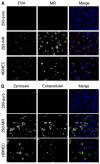Genetic and functional analysis of common MRC1 exon 7 polymorphisms in leprosy susceptibility
- PMID: 20035344
- PMCID: PMC2891106
- DOI: 10.1007/s00439-009-0775-x
Genetic and functional analysis of common MRC1 exon 7 polymorphisms in leprosy susceptibility
Abstract
The chromosomal region 10p13 has been linked to paucibacillary leprosy in two independent studies. The MRC1 gene, encoding the human mannose receptor (MR), is located in the 10p13 region and non-synonymous SNPs in exon 7 of the gene have been suggested as leprosy susceptibility factors. We determined that G396S is the only non-synonymous exon 7-encoded polymorphism in 396 unrelated Vietnamese subjects. This SNP was genotyped in 490 simplex and 90 multiplex leprosy families comprising 704 patients (47% paucibacillary; 53% multibacillary). We observed significant under-transmission of the serine allele of the G396S polymorphism with leprosy per se (P = 0.036) and multibacillary leprosy (P = 0.034). In a sample of 384 Brazilian leprosy cases (51% paucibacillary; 49% multibacillary) and 399 healthy controls, we observed significant association of the glycine allele of the G396S polymorphism with leprosy per se (P = 0.016) and multibacillary leprosy (P = 0.023). In addition, we observed a significant association of exon 7 encoded amino acid haplotypes with leprosy per se (P = 0.012) and multibacillary leprosy (P = 0.004). Next, we tested HEK293 cells over-expressing MR constructs (293-MR) with three exon 7 haplotypes of MRC1 for their ability to bind and internalize ovalbumin and zymosan, two classical MR ligands. No difference in uptake was measured between the variants. In addition, 293-MR failed to bind and internalize viable Mycobacterium leprae and BCG. We propose that the MR-M. leprae interaction is modulated by an accessory host molecule of unknown identity.
Figures





Similar articles
-
Leprosy as a genetic disease.Mamm Genome. 2011 Feb;22(1-2):19-31. doi: 10.1007/s00335-010-9287-1. Epub 2010 Oct 9. Mamm Genome. 2011. PMID: 20936290 Review.
-
Association of MBL2 Exon 1 Polymorphisms With Multibacillary Leprosy.Front Immunol. 2020 Sep 3;11:1927. doi: 10.3389/fimmu.2020.01927. eCollection 2020. Front Immunol. 2020. PMID: 33013845 Free PMC article.
-
CUBN and NEBL common variants in the chromosome 10p13 linkage region are associated with multibacillary leprosy in Vietnam.Hum Genet. 2014 Jul;133(7):883-93. doi: 10.1007/s00439-014-1430-8. Epub 2014 Feb 23. Hum Genet. 2014. PMID: 24563210
-
Genetic variants in the mannose receptor gene (MRC1) are associated with asthma in two independent populations.Immunogenetics. 2009 Dec;61(11-12):731-8. doi: 10.1007/s00251-009-0403-x. Epub 2009 Nov 10. Immunogenetics. 2009. PMID: 19902202
-
[The genetic susceptibility to leprosy in humans].Acta Leprol. 1996;10(1):11-27. Acta Leprol. 1996. PMID: 8967289 Review. French.
Cited by
-
Family-based genetics identifies association of CUBN, IL1RL1 and PRKN variants with leprosy in Bangladesh.Sci Rep. 2025 Mar 5;15(1):7653. doi: 10.1038/s41598-025-91995-w. Sci Rep. 2025. PMID: 40038446 Free PMC article.
-
Convergent and divergent mechanisms of sugar recognition across kingdoms.Curr Opin Struct Biol. 2014 Oct;28:14-22. doi: 10.1016/j.sbi.2014.07.003. Epub 2014 Aug 5. Curr Opin Struct Biol. 2014. PMID: 25102772 Free PMC article. Review.
-
Leprosy as a genetic disease.Mamm Genome. 2011 Feb;22(1-2):19-31. doi: 10.1007/s00335-010-9287-1. Epub 2010 Oct 9. Mamm Genome. 2011. PMID: 20936290 Review.
-
Association of TNF, MBL, and VDR polymorphisms with leprosy phenotypes.Hum Immunol. 2010 Oct;71(10):992-8. doi: 10.1016/j.humimm.2010.07.001. Epub 2010 Aug 1. Hum Immunol. 2010. PMID: 20650301 Free PMC article.
-
Macrophage immunoregulatory pathways in tuberculosis.Semin Immunol. 2014 Dec;26(6):471-85. doi: 10.1016/j.smim.2014.09.010. Epub 2014 Oct 30. Semin Immunol. 2014. PMID: 25453226 Free PMC article. Review.
References
-
- Alcais A, Alter A, Antoni G, Orlova M, Van Thuc N, Singh M, Vanderborght PR, Katoch K, Mira MT, Thai VH, Huong NT, Ba NN, Moraes M, Mehra N, Schurr E, Abel L. Stepwise replication identifies a low-producing lymphotoxin-[alpha] allele as a major risk factor for early-onset leprosy. Nat Genet. 2007;39:517–522. - PubMed
-
- Barrett JC, Fry B, Maller J, Daly MJ. Haploview: analysis and visualization of LD and haplotype maps. Bioinformatics. 2005;21:263–265. - PubMed
-
- Bell P, Chaturvedi S, Gelfand C, Huang C, Kochersperger M, Kopla R, Modica F, Pohl M, Varde S, Zhao R, Zhao X, Boyce-Jacino M, Yassen A. SNPstream UHT: ultra-high throughput SNP genotyping for pharmacogenomics and drug discovery. Biotechniques. 2002;(Suppl):70–2. 74, 76–7. - PubMed
-
- Boskovic J, Arnold JN, Stilion R, Gordon S, Sim RB, Rivera-Calzada A, Wienke D, Isacke CM, Martinez-Pomares L, Llorca O. Structural model for the mannose receptor family uncovered by electron microscopy of Endo180 and the mannose receptor. J Biol Chem. 2006;281:8780–8787. - PubMed
-
- Chakravartti M, Vogel F. A twin study on leprosy. In: Becker PE, Lenz W, Vogel F, Wendt GG, editors. Topics in human genetics. Vol. 1. Georg Thieme; Stuttgart: 1973. pp. 1–123.
Publication types
MeSH terms
Substances
Grants and funding
LinkOut - more resources
Full Text Sources
Medical
Molecular Biology Databases
Miscellaneous

